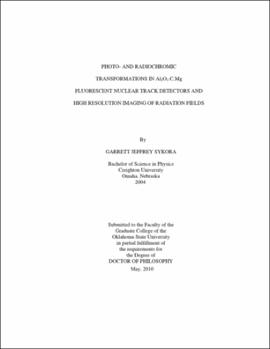| dc.contributor.advisor | Akselrod, Mark | |
| dc.contributor.author | Sykora, Garrett Jeffrey | |
| dc.date.accessioned | 2013-11-26T08:26:36Z | |
| dc.date.available | 2013-11-26T08:26:36Z | |
| dc.date.issued | 2010-05 | |
| dc.identifier.uri | https://hdl.handle.net/11244/6915 | |
| dc.description.abstract | Scope and Method of Study: The goal of this work was to develop fluorescent nuclear track detectors (FNTD) based on aluminum oxide doped with carbon and magnesium (Al2O3:C,Mg) as a multi-purpose radiation detection technology. The study focused on the optical properties of Al2O3:C,Mg as well as on the dosimetry of neutrons and mixed neutron-gamma fields utilizing a high resolution imaging system built as part of this research. A detailed investigation of optical properties using optical absorption and photoluminescence spectroscopy, radiation interaction in the sensitive volume, dose and energy response to different types of radiation and new applications of FNTDs was performed. This work demonstrated progress in all aspects of FNTD technology including basic material research, instrumentation development, new data and image processing, and characterization of FNTDs in multiple radiation fields including neutrons, gammas, X-rays, betas and heavy charged particles. | |
| dc.description.abstract | Findings and Conclusions: Identification and assignment of color centers to excitation/emission bands were performed for single and double oxygen vacancy defects in Al2O3:C,Mg as a result of thermal, photochromic and radiochromic transformations. A new laser scanning confocal fluorescence imaging system and image processing routines were developed exhibiting performance sufficient for automatic processing of large numbers of FNTDs at an acquisition time of 4s per image. A new image processing technique was developed using spatial frequency analysis which was shown to be linearly proportional to dose for all types of radiation tested in this study, most notably neutrons and gamma. Neutron-gamma separation was accomplished by applying spatial frequency analysis and a dosimeter configuration consisting of an FNTD in contact with two neutron sensitive converters (polyethylene or 6 LiF) and a third converter insensitive to neutrons (polytetrafluoroethylene). Investigations of FNTD technology for charged particle spectroscopy, microdosimetry, proton therapy, microbeam radiation therapy, accident dosimetry, fusion diagnostics and space dosimetry demonstrate that FNTDs can be applied in many fields requiring passive radiation dosimetry. | |
| dc.format | application/pdf | |
| dc.language | en_US | |
| dc.rights | Copyright is held by the author who has granted the Oklahoma State University Library the non-exclusive right to share this material in its institutional repository. Contact Digital Library Services at lib-dls@okstate.edu or 405-744-9161 for the permission policy on the use, reproduction or distribution of this material. | |
| dc.title | Photo- and radiochromic transformations in Al2O3:C,Mg fluorescent nuclear track detectors and high resolution imaging of radiation fields | |
| dc.contributor.committeeMember | Benton, Eric | |
| dc.contributor.committeeMember | Yukihara, Eduardo | |
| dc.contributor.committeeMember | Grischkowsky, Daniel | |
| osu.filename | Sykora_okstate_0664D_10766.pdf | |
| osu.accesstype | Open Access | |
| dc.type.genre | Dissertation | |
| dc.type.material | Text | |
| dc.subject.keywords | fluorescent nuclear track detector | |
| dc.subject.keywords | heavy charged particle spectroscopy | |
| dc.subject.keywords | high resolution imaging | |
| dc.subject.keywords | image processin | |
| thesis.degree.discipline | Physics | |
| thesis.degree.grantor | Oklahoma State University | |
